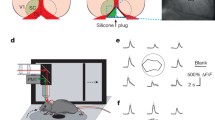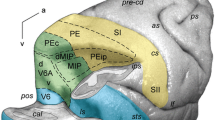Abstract
We studied the functional properties of rotation-sensitive (RS) neurons of the posterior parietal association cortex in detail. We classified 58 neurons as RS neurons on the basis of statistical analysis, to indicate that their responses to rotary movement were significantly greater (P<0.01) than those to linear movement of the same stimulus. We calculated rotation index, 1 — (L/R), in 82 cells, where L/R is the ratio of net response to linear movement to that to rotary movement. All the RS neurons had rotation index greater than or equal to 0.3. The recording site of these RS neurons was localized in the posterolateral part of area PG (area 7a of Vogt), on the anterior bank of the caudal superior temporal sulcus (STS), in the region partly overlapping the medial superior temporal (MST) area. We compared the response of RS neurons to rotation with that to shearing movement as well as to linear movement. In the majority of RS neurons the ratio of shearing response to rotation response (S/R) was smaller than the ratio of linear response to rotation response (L/R), indicating that the response to rotation was not due to a simple combination of linear movements in the opposite direction. Most of the RS neurons responded to the rotary movement of a single spot as well as that of a slit, although the response was smaller (average 70%) for the former. Most of the RS neurons had large receptive fields (60–180° in diameter) and their responses were independent of the position within the receptive field. The responses of most RS neurons increased monotonically with the increase in angular velocity and were also dependent on the size of the stimulus, although the rate of increase was small when the length was more than 10°. The majority of RS neurons (37/58) responded better to rotation in depth than to that in the frontoparallel plane. Some of them (12/37) responded to diagonal rotation rather than to sagittal or horizontal rotation. We found that some depth RS neurons showed reversal in the preferred direction when we used a trapezoidal window-like plate as the rotating stimulus in the monocular viewing condition, just as occurs in the case of the Ames window illusion. The response of some RS neurons (5/7) was enhanced by tracking eye movement. The enhanced responses were observed during rotary tracking but not during linear tracking. Other RS neurons (n = 2) showed maximum response to the rotation of the monkey chair in the light, as a result of convergence of visual and vestibular signals. We concluded that the continuous change of direction of movement was the most important cue for RS neurons to respond selectively to rotary movement in contrast to linear translational movement, and that these neurons were likely to discriminate the direction and orientation of the plane of rotation of the object in space.
Similar content being viewed by others
References
Akbarian S, Berndl K, Grusser O-J, Guldin W, Pause M, Schreiter U (1988) Responses of single neurons in the parietoinsular vestibular cortex of primates. Ann NY Acad Sci 545:187–202
Ames A (1951) Visual perception and the rotating trapezoidal window. Psychol Monographs 65
Andersen RA, Bracewell RM, Barash S, Gnadt JW, Fogassi L (1990) Eye position effects on visual, memory and saccade-related activity in areas LIP and 7a of macaque. J Neurosci 10:1176–1196
Andersen RA, Mountcastle VB (1983) The influence of the angle of gaze upon the excitability of the light-sensitive neurons of the posterior parietal cortex. J Neurosci 3:532–548
Boussaoud D, Ungerleider LG, Desimone R (1990) Pathways for motion analysis: cortical connections of the medial superior temporal and fundus of the superior temporal visual areas in the macaque. J Comp Neurol 296:462–495
Braunstein ML (1971) Perception of rotation in figures with rectangular and trapezoidal features. J Exp Psychol 91:25–29
Braunstein ML, Stern KR (1980) Static and dynamic factors in the perception of rotary motion. Percept Psychophys 24:313–320
Cavanagh P, Favreau OE (1980) Motion aftereffect: a global mechanism for the perception of rotation. Perception 9:175–182
Collewijn H, Van der Steen J, Ferman L, Jansen TC (1985) Human ocular counterroll: assessment of static and dynamic properties from electromagnetic scleral coil recording. Exp Brain Res 59:185–196
Desimone R, Ungerleider LG (1986) Multiple visual areas in the caudal superior temporal sulcus of the macaque. J Comp Neurol 248:164–189
De Yoe EA, Van Essen DC (1988) Concurrent processing streams in monkey visual cortex. Trends Neurosci 11:219–226
Duffy CJ, Wurtz RH (1991a) Sensitivity of MST neurons to optic flow stimuli. I. A continuum of response selectivity to large field stimuli. J Neurophysiol 65:1329–1345
Duffy CJ, Wurtz RH (1991b) Sensitivity of MST neurons to optic flow stimuli. II. Mechanisms of response selectivity revealed by small-field stimuli. J Neurophysiol 65:1346–1359
Freeman TC, Harris MG (1992) Human sensitivity to expanding and rotating motion: effects of complementary masking and directional structure. Vision Res 32:81–87
Gattass R, Gross CG (1981) Visual topography of striate projection zone (MT) in posterior superior temporal sulcus of the macaque. J Neurophysiol 46:621–638
Gibson JJ (1966) The senses considered as perceptual systems. Houghton-Mifflin, Boston
Graham CH, Gillam BJ (1970) Occurrence of theoretically correct responses during rotation of the Ames window. Percept Psychophys 8:257–260
Grusser O-J, Pause M, Schreiter U (1990) Vestibular neurons in the parieto-insular cortex of monkey (Macaca fascicularis): visual and neck receptor responses. J Physiol (Lond) 430:559–583
Hershenson M (1987) Visual system responds to rotation and size-change of complex proximal motion patterns. Percept Psychophys 42:60–64
Johansson G, Jansson G (1968) Perceived rotary motion from changes in a straight line. Percept Psychophys 4:165–170
Kaiser M-K, Calderone JB (1991) Factors influencing perceived angular velocity. Percept Psychophys 50:428–434
Kawano K, Sasaki M, Yamashita M (1984) Response properties of neurons in posterior parietal cortex of monkey during visual-vestibular stimulation. I. Visual tracking neurons. J Neurophysiol 51:340–351
Koendrink JJ (1986) Optic flow. Vision Res 26:161–179
Komatsu H, Wurtz RH (1988) Relation of cortical area MT and MST to pursuit eye movements. I. Localization and visual properties of neurons. J Neurophysiol 60:580–603
Liaw J-S, King IK, Arbib MA (1993) Visual perception of translational and rotational motion. In: Neural networks in vision. Progress in neural networks. Ablex, Norwood N.J. (in press)
Maunsell JHR, Van Essen DC (1983a) Functional properties of neurons in middle temporal visual are of the macaque monkey. I. Selectivity for stimulus direction, speed and orientation. J Neurophysiol 49:1127–1147
Maunsell JHR, Van Essen DC (1983b) Functional properties of neurons in middle temporal visual area of the macaque monkey. II. Binocular interactions and sensitivity to binocular disparity. J Neurophysiol 49:1148–1167
Maunsell JHR, Van Essen DC (1983c) The connections of the middle temporal visual area (MT) and their relationship to a cortical hierarchy in the macaque monkey. J Neurosci 3:2563–2586
Mishkin M, Ungerleider LG, Macko KA (1983) Object vision and spatial vision: two cortical pathways. Trends Neurosci 6:414–417
Motter BC, Mountcastle VB (1981) The functional properties of the light-sensitive neurons of the posterior parietal cortex studied in waking monkeys: foveal sparing and opponent vector organization. J Neurosci 1:3–26
Murch GM (1970) Perception of rotary movement. J Exp Psychol 86:83–85
Perrett DI, Smith PAJ, Mistlin AJ, Chitty AJ, Head AS, Potter DD, Broennimann R, Milner AD, Jeeves MA (1985) Visual analysis of body movements by neurones in the temporal cortex of the macaque monkey: a preliminary report. Behav Brain Res 16:153–170
Petersik JT, Shepard A, Malsch R (1984) A three-dimensional motion after-effect produced by prolonged adaptation to a rotation stimulation. Perception 13:487–497
Petersik JT (1991) Perception of three-dimensional angular rotation. Percept Psychophys 50:465–474
Power RP, Day RH (1973) Constancy and illusion of apparent direction of rotary motion in depth: test of a theory. Percept Psychophys 13:217–223
Regan D, Beverley KI (1985) Visual response to vorticity and the neural analysis of optic flow. J Opt Soc Am [A] 2:280–283
Regan D (1986) Visual processing of four kinds of relative motion. Vision Res 26:127–145
Roy J-P, Komatsu H, Wurtz RH (1992) Disparity sensitivity of neurons in monkey extrastriate area MST. J Neurosci 12:2478–2492
Saito H, Yukie M, Tanaka K, Hikosaka K (1986) Integration of direction signals of image motion in the superior temporal sulcus of the macaque monkey. J Neurosci 6:145–157
Sakata H, Shibutani H, Kawano K (1983) Functional properties of visual tracking neurons in posterior parietal association cortex of the monkey. J Neurophysiol 49:1364–1380
Sakata H, Shibutani H, Kawano K, Harrington TL (1985) Neural mechanisms of space vision in the parietal association cortex of the monkey. Vision Res 25:453–463
Sakata H, Shibutani H, Ito Y, Tsurugai K (1986) Parietal cortical neurons responding to rotary movement of visual stimulus in space. Exp Brain Res 61:658–663
Sakata H (1991) Neural correlates of the perception of depth rotation in the parietal association cortex of the monkey. Biomed Res [Suppl 2] 12:149–151
Sakata H, Kusunoki M, Tanaka Y (1993) Neural mechanisms of perception of linear and rotary movement in depth in the parietal association cortex of the monkey. In: Ono T, Squire LR, Raichle ME, Perrett DI, Fukuda M (eds) Brain mechanisms of perception and memory. Oxford University Press, Oxford, pp 166–182
Steinmetz MA, Motter BC, Duffy CJ, Mountcastle VB (1987) Functional properties of parietal visual neurons: radial organization of directionalities within the visual field. J Neurosci 7:177–191
Tanaka K, Saito H (1989) Analysis of motion of the visual field by direction, expansion/contraction, and rotation cells clustered in the dorsal part of the medial superior temporal area of the macaque monkey. J Neurophysiol 62:626–641
Tanaka K, Fukada Y, Saito H (1989) Underlying mechanisms of the response specificity of expansion/contraction and rotation cells in the dorsal part of the medial superior temporal area of the macaque monkey. J Neurophysiol 62:642–656
Ungerleider LG, Desimone R (1986) Cortical connections of visual area MT in the macaque. J Comp Neurol 248:190–222
Vogt C, Vogt O (1919) Allgemeinere Ergebniss unserer Hirnforschung. J Psycholog Neurolog 25:279–461
Zeki S, Shipp S (1988) The functional logic of cortical connections. Nature 335:311–317
Author information
Authors and Affiliations
Rights and permissions
About this article
Cite this article
Sakata, H., Shibutani, H., Ito, Y. et al. Functional properties of rotation-sensitive neurons in the posterior parietal association cortex of the monkey. Exp Brain Res 101, 183–202 (1994). https://doi.org/10.1007/BF00228740
Received:
Accepted:
Published:
Issue Date:
DOI: https://doi.org/10.1007/BF00228740




